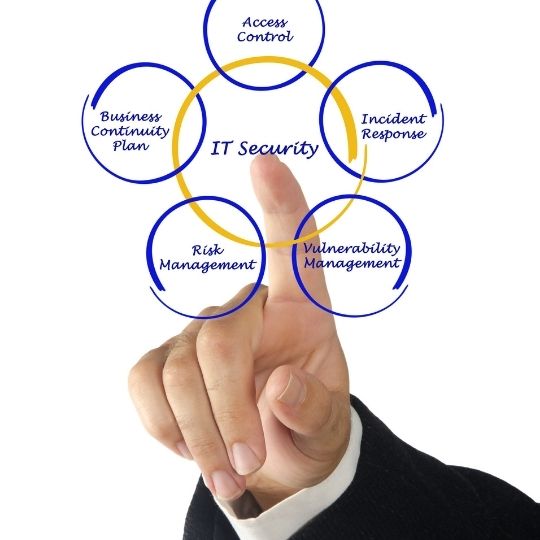Wooden Spoon: Blog

Building an Effective IT Security Framework
The rapid spread of digital technology enables businesses to quickly launch new products and services to meet shifting market demands. Although the digital world offers boundless growth and value creation possibilities, it also opens the door to an array of new security risks. Data breaches present the most persistent threat and underscore the need for a robust, well-planned IT security strategy.
Whether caused by a deliberate strike or human or technical error, a single data breach can prove catastrophic for any business. But it’s not only the disruption and potential loss of income that can be so detrimental. Data breaches can create negative public perceptions that can severely impact an organization’s brand and reputation.
Establishing a secure and well-protected IT environment in today’s rapidly shifting threat landscape requires a proactive approach—assessing vulnerabilities, updating technology and security defenses, and monitoring for vulnerabilities. It can’t be entirely accomplished in a month or two. So what’s the best approach? Create a long-term plan built around proven best practices.
What is IT Security and What Does it Cover?
While both cybersecurity and IT security are designed to safeguard information, IT security refers to a broader area that focuses on protecting data (both digital and analog) from any kind of threat. Effective IT security centers around three core pillars. These pillars aim to protect and preserve the confidentiality, integrity, and availability of data.
- Technology. Businesses have an array of techniques at their disposal to help mitigate risks and detect and prevent threats. Technical and procedural controls define who is allowed access to enterprise networks, devices, and applications. It can help safeguard data while in use or when someone accesses it. Access controls, encryption tools, and authentication techniques can help make sure that only authorized users can gain entry to your applications and data and offer an extra barrier of protection against network attacks.
- Processes. Usage policies and procedures define what behaviors are and aren’t acceptable and outline the steps employees must take to keep data and property safe. This includes defining the roles and responsibilities for data protection activities based on your organization’s usage preferences and requirements specific to your particular market or industry sector.
- People. The people who use the technology and access data daily represent your frontline defense. Therefore, they must understand the risks and be trained and educated on security protocols, online practices, and how to recognize potential threats and respond to security incidents. Clear communication and transparency are vital to fast, efficient recovery and damage mitigation.
Building a Solid Foundation
 Today’s IT environments are becoming increasingly more complex and diverse, making it more challenging to identify vulnerabilities and threats that could put your data and business assets at risk. The good news is that establishing a secure IT environment is possible with the right blend of security best practices, sound policies, and proactive technology planning. The process begins with a detailed evaluation of your IT security framework and your company’s core data protection needs and priorities.
Today’s IT environments are becoming increasingly more complex and diverse, making it more challenging to identify vulnerabilities and threats that could put your data and business assets at risk. The good news is that establishing a secure IT environment is possible with the right blend of security best practices, sound policies, and proactive technology planning. The process begins with a detailed evaluation of your IT security framework and your company’s core data protection needs and priorities.
- IT assessment. An IT assessment shows how well your security systems are performing, whether your underlying infrastructure supports your operational goals. It will also show how to take full advantage of existing resources and technology. The assessment provides valuable insight into your security strengths and weaknesses. Furthermore, it highlights cost efficiency improvement opportunities and provides greater clarity for making difficult IT investment decisions. This is where an experienced IT consultant can prove instrumental. They can help to develop the right technology roadmap for your business. They provide a strategic view towards long-term growth, optimum risk mitigation, and maximum technology leverage.
- Threat detection and access controls: Sophisticated detection methods, including predictive analytics and machine learning tools, can help uncover anomalies and vulnerabilities much more precisely and accurately than many traditional security These systems analyze real-time data to compare events and identify individual patterns of behavior or irregularities that may signify a security breach. Meanwhile, application and procedural controls can help prevent unauthorized users from accessing or launching applications on enterprise devices. They can also help protect the network from potential threats with their ability to block (unauthorized or soon-to-be-departing) employees from access to mission-critical applications and systems.
- A culture of security. A large percentage of data breaches originate from inside the organization―whether through incidental or malicious acts. These types of data breaches are frequently the most expensive and difficult to solve. That’s why it’s important to create a culture where employees are focused on security and make it a clear priority. But employees can’t practice good security if they aren’t educated in what best practices are or aren’t informed of the latest threats and how to spot them. That’s why it’s vital to teach employees about safe Internet practices and how to identify social engineering and phishing attacks. Test their security knowledge and awareness with mock attacks, simulations, and interactive security tasks and activities.
- Backup and recovery. In the event of a data breach or loss of information, you need the ability to recover quickly. Consider engaging with an experienced IT consultant who will work with you to evaluate your internal processes and develop a recovery plan that protects data and assets and provides reliable protection against ongoing threats. Make sure you have reliable backups of all your data and test your recovery processes regularly. This ensures they will execute properly when you need them.
Reaping the Benefits of Intelligent Planning
Protecting your confidential data and intellectual property is not just a security issue; it is a fundamental business concern. It requires an intelligent, well-planned investment in technology and resources to meet an increasingly complex threat landscape.
Although building an effective IT security framework is a quick and easy process, businesses cannot afford to wait. Cybercriminals are continuously seeking new ways to penetrate your defenses. This underscores your need to remain up to speed on the latest threats and defensive strategies. You must remain vigilant to safeguard your data and business assets at all times.






